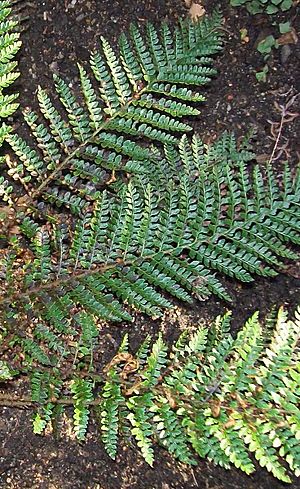Mother shield fern facts for kids
Quick facts for kids Mother shield fern |
|
|---|---|
 |
|
| Mother shield fern from Barrington Tops National Park, Australia | |
| Scientific classification | |
| Genus: |
Polystichum
|
| Species: |
proliferum
|
The Mother shield fern (scientific name: Polystichum proliferum) is a special type of fern found only in Australia. Its scientific name, Polystichum, comes from Greek words meaning "many rows." This refers to how its spores are arranged. The second part of its name, proliferum, is Latin for "offspring-bearing." This is because it can grow new plants from its leaves!
Contents
What Does It Look Like?
The Mother shield fern grows on the ground. It can reach up to 130 centimeters (about 4.3 feet) tall. The base of its stem, called a rhizome, and the bottom of its leaves have shiny brown scales. These scales have light-colored edges.
Its leaves, called fronds, can grow very long. They can be up to 100 centimeters (about 3.3 feet) long and 30 centimeters (about 1 foot) wide. Young fronds are lighter green, while older ones are dark green.
Underneath the fronds, you'll find small clusters of spores. These clusters are called sori. They grow in neat rows on both sides of the main vein of the leaf. Each sorus is covered by a protective, umbrella-like shield. This shield is called an indusium. This protective cover is why it's called the "mother shield fern."
Where Does It Live?
The Mother shield fern is very common in Australia. You can find it from sea level all the way up to 1300 meters (about 4,265 feet) high. It mostly lives in the tablelands and mountain ranges. These areas include New South Wales, Victoria, the Australian Capital Territory, and Tasmania.
At higher places, it often grows among large rocks. In lower areas, it prefers wet forests. This fern loves cool, moist spots. It often grows in gullies and near creeks. It also likes slopes that face south or east, where it's shadier.
This fern is quite tough! It can even grow in drier places. You might see it in coastal scrub or dry forests. It can handle salty winds and poor soil. People sometimes confuse it with another fern, Dicksonia antarctica, because they look similar.
How Does It Reproduce?
The Mother shield fern can make new plants in two ways. It can reproduce using special buds or by releasing tiny spores.
Making New Plants from Buds
This fern has a cool trick called vegetative reproduction. Small plantlets, called bulbils, grow at the end of its larger fronds. As these bulbils get bigger, they become heavier. The frond bends down until the bulbil touches the soil. Once it touches the ground, the bulbil can grow roots and become a new plant!
This ability helps the Mother shield fern spread out quickly. After a forest disturbance, like a fire, it can often become the main plant covering the ground. Gardeners also like this feature because it makes the fern easy to grow at home.
Making New Plants from Spores
Like many ferns, the Mother shield fern also reproduces using spores. These tiny, dust-like particles are released from the sori under the fronds. When spores land in a good spot, they can grow into new fern plants.
Images for kids



